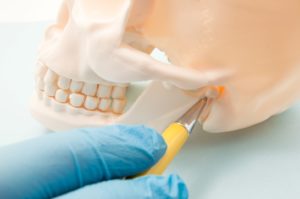 The temporomandibular (TM) joint is located on either side of the face to connect the lower jaw to the skull. Sometimes, the joint can function incorrectly, known as a temporomandibular joint disorder (TMD). Commonly misreferred to as a TMJ disorder, it’s often believed only adults are vulnerable to the condition; however, children can be affected by it as well. It’s estimated 6-68% of children and adolescents suffer from it, which is often triggered by emotional stress. Children with TMD in South Windsor don’t need to live with reoccurring jaw pain. Here’s how you can spot the signs to get them the relief they need.
The temporomandibular (TM) joint is located on either side of the face to connect the lower jaw to the skull. Sometimes, the joint can function incorrectly, known as a temporomandibular joint disorder (TMD). Commonly misreferred to as a TMJ disorder, it’s often believed only adults are vulnerable to the condition; however, children can be affected by it as well. It’s estimated 6-68% of children and adolescents suffer from it, which is often triggered by emotional stress. Children with TMD in South Windsor don’t need to live with reoccurring jaw pain. Here’s how you can spot the signs to get them the relief they need.
Causes of TMD in Children
A TMD is classified as a condition relating to issues with the temporomandibular joint, such as clicking, popping, or grating sounds when opening and closing the mouth. In some instances, the jaw can even lock into an opened or closed position. Facial pain and overall discomfort are common, which can make it difficult to perform simple tasks, like biting, chewing, or yawning.
Although it’s not clear the exact cause of a TMD, several factors can contribute to it, like bruxism. Habitual grinding and clenching the teeth can cause the TM joint to become aggravated and inflamed. Not only can bruxism lead to TMD, but jaw pain can cause grinding and clenching to worsen, which can lead to dental problems, including tooth loss.
While adults can develop TMD from arthritis, past trauma, or muscles problems, bruxism is the most common cause in children. With stress as a leading contributor to clenching and grinding, it’s important to see a dentist right away to save your child’s smile.
Signs of TMD in Children
TMD can cause a variety of symptoms, which may often seem unrelated, like earaches or neck pain. Although the complications are diverse, here are a few of the most common signs your child needs to see a dentist for treatment:
- Facial pain around the TM joint, ear, neck, or shoulders.
- Pain when opening or closing the mouth, such as when chewing.
- Clicking, popping, or grating sound when moving the jaw.
- Difficulty chewing or biting.
- Headaches or dizziness.
- Ear pain, ringing in the ears, or hearing loss.
- Jaw locking.
Treating TMD in Children
If your child has TMD, there are several noninvasive solutions to relieve their discomfort, such as:
- Resting the jaw for a few days.
- Offering softer foods that are easier to chew.
- Avoiding anything that might aggravate the joint, like chewing gum.
- Applying cold compresses to the outside of the face.
- Practicing stress-relieving exercises.
- Fixing an improper bite.
- Fitting a splint or biteplate to wear at night.
If you suspect your child has bruxism or an issue with their TM joint, don’t wait. Contact their dentist to preserve their smile and improve their jaw’s functions.
About Dr. Sara E. Curcio
Dr. Curcio earned her dental degree at the University of Connecticut School of Dental Medicine. She is passionate about creating healthy, beautiful smiles for children using the latest advancements in dentistry. She has the qualifications and training to treat complex issues, like TMD. Contact our office today to schedule your child’s consultation for TMJ therapy.
